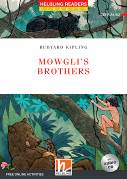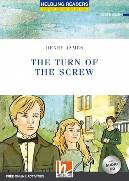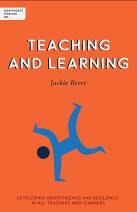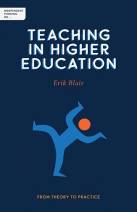Short Book Reviews
Hanna Kryszewska is a teacher, teacher trainer, trainer of trainers. She is a senior lecturer at the University of Gdańsk, Poland. She is co-author of resource books: Learner Based Teaching, OUP, Towards Teaching, Heinemann, The Standby Book, CUP, Language Activities for Teenagers, CUP, The Company Words Keep, DELTA Publishing, and a course book series for secondary schools: ForMat, Macmillan. She is also co-author of a video based teacher training course: Observing English Lessons. Hania is a Pilgrims trainer and editor of HLT Magazine.
E-mail: hania.kryszewska@pilgrims.co.uk


Helbling Readers Classics. Books with Audio CD and Online Access Code Helbling Languages (2020). The new titles include: (A1/A2) Mowgli’s Brothers. R. Kipling. ISBN-978-3-99089-261-9, pp 92, (A2/B2) and The Turn of the Screw. H. James. ISBN-978-3-99089-113-1, pp 92. Books in this series of graded reading materials come at five levels – 3 KET levels (colour coded in red) and at two PET levels (colour coded in blue). In this selection of five titles, some are aimed at younger learners, and some at more mature ones. The books are adaptations of well-loved classics which are popular among native speakers, so obviously the stories are interesting and a good read. First language learners become familiar with the author, the story behind the book, and then the characters. Next they do some vocabulary activities which introduce key lexis in the book. Then as they read the story they can see the new words marked with a dot (and explained at the bottom of the page). They can also listen to the whole story and do activities available on an accompanying audio CD. As they read the story they can do some short while-reading mini tasks which usually involve answering some content related questions or require interpretation of the story or events. Finally, after the readers have finished reading of the story, they can do some post-reading activities referring to the content, the learning experience, and elements of grammar and lexis present in the book. The readers are pleasant to the eye thanks to good illustrations and careful page design, and each book is illustrated in its own individual style so it has a feeling of uniqueness about it. This series of graded readers is well-established and popular among language learners as additional reading and CLIL material. More free online activities are available from www.helbling-ezone.com
Silly Shakespeare for Students. ISBN-978-1-948492-71-3, pp 84, Pericles Prince of Tyre. ISBN-978-1-948492-73-7, pp 92. Macbeth. ISBN-978-1-948492-74-4, pp 112. P. L. Murray with the help of William Shakespeare. (2020). Alphabet Publishing. You can tell the books in the series are a lot of fun just when you look at covers which, obviously, give the names of the authors: P. L. Murray with the help of William Shakespeare! Paul Murray has a good sense of humour and has a new way of looking at adapting the famous plays. Each of the books contains adaptations from Shakespeare, in which the plot and the spirit have been preserved to some extent. But unlike most simplified or graded adaptations intended for the EFL class, the texts also rhyme. In this way Shakespeare is accessible without losing the fun, rhythm and offers glimpses of Shakespeare’s genius. Each book contains the adapted text of the play, which is preceded by a summary of the playing style. It is important as the author takes a new perspective: Macbeth is full of humour and is told from the point of view of the witches, Pericles is pretty light-hearted and lends itself to a performance in the style of Comedia del Arte, while A Midsummer Night’s Dream is fun filled and encourages the actors to improvise and add their own lines. The plays are suitable for language classes, drama classes or student productions. An EFL teacher may need to do some language work with more sophisticated vocabulary for the sake of lower lever students. The book would benefit from some glossary and vocabulary work. Overall great stuff. For more words of praise go to:
https://www.alphabetpublishingbooks.com/shakespeare/
American Studio Upper Intermediate. Student’s book. L. Clandfield and P. Kerr. (2021) Helbling Languages. ISBN-978-3-99089-172-8, pp 160. This course book is one in the new six level course for adult learners. At least this is what the publisher says, but in my opinion, it would be also suitable for young adults. The book gradually develops all four language skills but offers extensive opportunities for developing listening skills through audio and video recordings. The productive skills and receptive skills are grouped together while vocabulary is introduced and recycled throughout the whole book. The course is supported by on-line resources: Studio Digital Zone (extra listening and reading, student’s workbook vocabulary practice and videos), e-online practice (cyber homework, projects and exam bank) and Helbling Media App (audio and video, pair work activities and vocabulary practice). The pie chart below sums it up really well:
This is a truly modern course making use of the potential of learning online and mobile technology; the authors and publishing house have clearly made sure of that. It is a great shame though that the course does not take on board recent developments in teaching in Europe, especially clearly implementing mediation as defined by CEFR (2018). Also it is hard for me to tell in what way it is American compared to the other version of the coursebook. More information about the course at https://www.helbling.com/studio/ and
https://www.helblinglanguages.com/int/en/studio/studio-upper-intermediate


Independent Thinking on…
This is a new series presenting the voices of the Independent Thinking Associates. It is part of the movement’s way to rethink the aims and essence of education and the challenges it faces. The authors are among the most inspiring and erudite thinkers, educators and practitioners in the UK. The handy pocket size of the books makes them ideal for carrying around and reading whenever you have a free moment.
Teaching and Learning. J. Beere. (2020) Independent Thinking Press. ISBN 978-178135339-4, pp 218. The aim of the book is to help teachers inject more energy and passion into their teaching, which consequently will benefit the learners and affect their students and their learning. It is aimed at teachers and educational leaders of all age groups, so EFL teachers teaching at different language levels can find some inspiration as well. Research and classroom observation show that teachers are pivotal figures who ensure educational success. Therefore it is the teachers who are in the centre of the book. The author encourages teachers to enjoy change, work on their relationships with their learners, see learners as equal partners and work towards fulfilling everyone’s potential, including the teacher’s potential. The titles of the chapters in the book are the best summary of the areas covered, for example unleashing your teacher power looks at rapport and mindsets, while taking control of metacognition looks at various areas of higher order thinking skills in the classroom. The book also looks at: ways of delivering lessons, being present in the classroom and engaging in the lesson, fair and motivating assessment, memory training (including retention and mnemonic techniques), elements of coaching, and finally developing character traits crucial for a successful teacher. The book is a must read for every teacher who wants to work on their professional development.
Teaching in Higher Education. E. Blair (2020) Independent Thinking Press. ISBN 978-178135369-1, pp148. The book comes from an expert with over 20 years of experience in teaching at university level. I myself, a teacher who has taught at academic level for 41 years, can clearly see and feel his expertise. I appreciate his practical and bite-size bits of wisdom; they are spot on. I believe all teachers teaching at higher levels, both more and less experienced, will find in this book something new or will find confirmation their own classroom practices. First the book looks at the aims of higher education, the hefted expectations and importance of success. The author highlights three challenges in this area: looking at the learning process from the students’ perspective, focusing more on the learning rather than the teaching, keeping a balance between supporting the students and fostering their independence, and, finally, promoting the students’ self-reliance and self-directed growth. The next sections focus on structuring the teaching process, individual sessions and whole courses, the flow of information, assessment, and finally offer some reflection on the reader’s personal experience and ways to move forward. My favourite parts of the book are: “Little Nuggets of Wisdom” – one sentence spot-on comments and reflections on the subjects covered in the given chapter, and at the end of the book “Ten Big Nuggets to Reflect On” – ten paragraphs devoted to such areas as: students willingness to learn, the role of the staff who are there for the students, democratic treatment of students and many other important issues.
Structuring Fun for Young Learners in the ELT Classroom. C. Roland. (2020) Pavilion ELT. ISBN 9781913414535, pp 364. The title of the book may be puzzling at first glance: you may wonder how it is possible to structure fun. But it has to be borne in mind that it is not about fun in general or wild and crazy fun, but fun in the context of a YL language classroom at school. Teachers tend be wary of fun in the classroom in case their lessons get chaotic, noisy, no teaching and learning takes place or their learners get out of hand. The book offers practical ideas to inspire teachers to engage and motivate their learners in a structured and manageable way. The first part of the book (about 100 pages) looks at working with young learners in general, classroom management, creativity for young learners and teaching content (words, sentences and scripting events). Basically this parts maps out the essence and key points of teaching young learners. Then follow 10 chapters devoted to various aspects of teaching YL and areas to have ‘fun’ in. For example, the first chapter is devoted to what the author calls ‘novelty object’, which looks at new ways in which we can use everyday objects and put them effective and creative use in the foreign language classroom. The activities are illustrated with diagrams, pictures or photos, which help the readers follow the procedures more easily. The book is full of great ideas and the rationale is clearly presented, which will make the book of great use to both less and more experienced teachers. The character of the book is more like a manual than a resource book, which means the reader has to read the whole chapter to find out about the author’s ideas. It is not possible to just dip into it having looked up one or two activities in the contents page. This book would be a great manual on pre-service courses for teachers of young learners, or refresher courses for in-service teachers. It fits the description on the cover perfectly: Practical ideas and advice for teaching English to children to engage them and inspire them throughout their primary schooling.
The Creative Teacher’s Compendium. A. Clare and A. Marsh. (2020) Pavilion ELT. ISBN 9781913414528, pp 405. The book belongs to the Teaching English series by ELT Pavilion. By now it is a well-established series very positively received by language teachers. I have looked through the book with great pleasure and what warmed me up to it straight away was Antonina’s statement: We stand on the shoulders in giants. Indeed a book on creativity does not spring from nowhere. There are predecessors - educators and authors - who have influences the authors’ current thinking about creativity and whose ideas on creativity have inspired the authors to create their own variations or completely new activities. Reading the list of acknowledgments and names of the people who have had an influence on the authors is like reading the list of distinguished presenters at a conference, many of whom have also published in HLT. When I was reading on the cover (under the title): An A-Z guide of creative activities for the language classroom I had my doubts. How can you have an A-Z of creativity? To me A-Z suggests there is a beginning and an end… but creativity has no beginning or end. Also A-Z can mean everything about creativity, exhaustive opus, everything you need to know and nothing more... but then you will never be able to have the final word in this area as the nature of creativity is that it keeps redefining itself and is fluid. The A-Z idea becomes clear when you look at the contents page. This is the organising principle of the book: A – stands for Art, B – stands for Beginnings, C – for Conversations etc. . . . (You can try to complete the alphabet list of creative ideas and then check against the contents page and see what the authors thought. This is a nice creative activity about creativity in itself!). Each section contains 4-6 activities which are ready to use, fresh and motivating, both for the learners and the teacher. The book is user friendly as the authors indicate the timing and the level; the procedure is straightforward to follow. There is visual material accompanying some of the activities, and more at the end of the book where appropriate. This is a very hands-on dip-in resource book; the authors spare you long introductions about creativity. Just 18 pages! Instead there is a feast of creativity for you to enjoy.
Please check the Methodology and Language for Primary course at Pilgrims website.
Please check the Methodology and Language for Secondary course at Pilgrims website.
Please check the CLIL for Secondary course at Pilgrims website.
Please check the Improvisation Techniques for the English Classroom course at Pilgrims website.
Please check the Acting Skills for the English Classroom course at Pilgrims website.
Please check the Culture in the English Speaking world for the English classroom course at Pilgrims website.
Please check the Creative Methodology for the Classroom course at Pilgrims website.
Please check the The Art and Skills of the Humanistic Teacher Trainer course at Pilgrims website
Review of: Expanding Literacy Practices across Multiple Modes and Languages for Multilingual Students
Amber Deig, USShort Book Reviews
Hanna Kryszewska, PolandNew Title from Crown House Publishing: Making Every RE Count
New Title from Crown House: Emotional Literacy
Delta Publishing: New Term, New Books